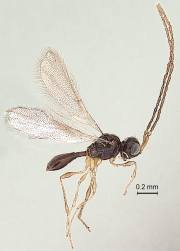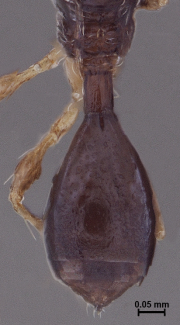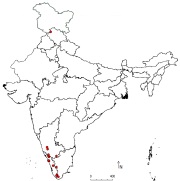 Fig 1. Body, dorsal view |
 Fig 2. Body profile |
|
 Fig 3. Antenna (female) |
 Fig 4. Antenna (male) |
 Fig 5. Forewing with tip incised |
 Fig 6. Metasoma |
 Fig 7. Distribution map |
|
Nomenclature
Entomacis Förster, 1856: 121, 123. Type species: Diapria (Glyphidopria) platyptera Haliday.
Hemilexis Förster, 1856: 121, 123, 127. Synonymized by Dalla Torre, 1898.
Glyphidopria Haliday, 1857: 172. An objective junior synonym of Entomacis Förster.
Hemilexodes Ashmead, 1893: 386, 399. Synonymized by Masner and Muesebeck in Krombein and Burks, 1967.
Adeliopria Ashmead, 1902: 15. Synonymized by Masner, 1964:123-155.
Diagnosis
1-3mm long gracile forms, usually yellowish brown to brown or blackish brown or black, with smooth and shining body, lacking micropilosity, but with sparse long semierect hairs. Never with foam-like structures.
Head mostly globular in dorsal view. Antennal shelf not much developed. Antennae in both sexes 13-segmented. Female antennae feebly thickened towards tip, without a distinct clava, A13 larger and longer than A12. Hairs irregularly scattered and at least as long as width of A2. Male antennae filiform, segments long and cylindrical, A3 subequal to or slightly shorter than A4, A3-A13 with long hairs, A4 enlarged or modified with sharp ridge or carina. Eyes large, subcircular, with distinct convex ommatidia. Malar sulcus not distinct. Mandibles normal, not protruding beak-like. Post gena without a dense cushion of hairs. Occipital flange narrow.
Mesosoma in lateral view highly convex. Pronotal shoulders not angular, sides without a hairy cushion, pronotal rim with sparse long hairs. Mesoscutum with or without notauli. Humeral sulcus at times indicated, anterior scutellar pit large, subrectangular, at times with irregular longitudinal striae or rugosity on lower margin. Lateral and posterior scutellar pits often lacking. Sternaulus absent. Mesopleuron highly convex, with a subcircular matted spot above midcoxa. Dorsellum medially with three longitudinal keels or ridges. Propodeum with scattered pilosity and with a distinct keel often projecting medially, sometimes like a spine. Lateral carinae or plicae distinct. Posterodorsal corners of propodeum acute.
Wings usually well developed. Forewing truncate at apex or with a distinct emargination. Venation reaching beyond its proximal one-third. Submarginal vein remote from costal margin. Stigmal vein well developed, at least as long as or often longer than marginal. A nebulous, non-arcuate basal vein sometimes indicated. Distal radial sector never indicated. Marginal cilia often well developed, as long as one-third width of forewing. Hindwings with submarginal vein complete.
Petiole cylindrical, at least as long as wide or longer, with distinct longitudinal striae, not concealed by pubescence, hairs long but sparse. Metasoma slender and elongate, in males extremely narrow, often with a triangular tip. T2 at its dorsal anterior margin sometimes with a small longitudinal cleft or furrow, basal tergites often telescoped under T2, forming a broad short triangle.
Geographic Distribution
See distribution map (Fig.7).
Species known from India
1. Entomacis balloonus Rajmohana & Narendran
2. Entomacis completus Rajmohana & Narendran
3. Entomacis indicus Sharma
4. Entomacis keralensis Rajmohana & Narendran
5. Entomacis linealis Rajmohana & Narendran
6. Entomacis spinosus Rajmohana & Narendran
Remarks
Not very common in collections. The following combination of characters aids in distinguishing this genus from other Diapriinae: delicate body, indistinct antennal shelf, normal mandibles, reduced genal cushion and foamy scale-like structures, 13-segmented antennae in both sexes, female antennae without an abrupt clava, anterior scutellar pit monofoveate, forewing margin distally truncate or medially emarginate, submarginal vein remote from fore margin of wings, a well developed marginal cilia, metasoma narrow, often with a triangular tip.
References
Ashmead, W. H. 1893. Monograph of the North American Proctotrypidae. United States National Museum Bulletin 45: 1-472.
Ashmead, W.H. 1902. A new genus of diapriids from Texas. Biological Bulletin, 3: 15.
Dalla Torre, K. W. v. 1898. Catalogus hymenopterorum hucusque . . . IV: Braconidae. 1-323.
Förster, A. 1856. Hymenopterologische Studien. II. Heft. Chalcidiae und Proctotrupii, 2: 1-152. Aachen: Ernsteer Meer.
Haliday, A. H. 1857. Note on a peculiar form of the ovaries observed in a hymenopterous insect, constituting a new genus and species of the family Diapriidae. Natural History Review 4: 166-174.
Krombein K. V., and Burks, B. D. 1967. Hymenoptera of America north of Mexico. Synoptic Catalog. United States Department of Agriculture Monograph 2(2nd suppl.): 1-584. Washington.
Masner, L. 1964. A comparison of some Nearctic and Palearctic genera of Proctotrupoidea (Hymenoptera) with revisional notes. Cˇ asopis Cˇ eskoslovenske´ Spolecˇnosti Entomologicke,´ 61: 123-155.
Rajmohana, K and Bijoy, C., 2012. A checklist of Diapriidae and Proctotrupidae (Hymenoptera: Insecta) from India.
|